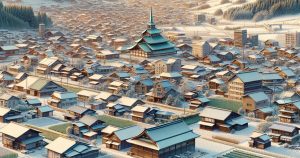| population | 6,768 peoples |
|---|---|
| area | 1,099.37 km² |
| population density | 6.16 peoples/km² |
Shibecha Town, nestled in the heart of eastern Hokkaido within the Kushiro Wetland region, is a place where people live in harmony with magnificent nature. The name “Shibecha” comes from the Ainu word “si-pet-cha,” meaning “the large riverbank,” referring to the majestic Kushiro River that flows through the town. After World War II, settlers from Honshu developed the land, establishing today’s Shibecha. Its main industry is dairy farming, supported by fertile soil and cool climate, producing some of the finest milk and dairy products in Hokkaido. About 65% of the Kushiro Shitsugen National Park lies within the town’s borders, providing habitats for numerous species of wildlife. Visitors can experience untouched nature through canoeing, birdwatching, and seasonal tours. From sweeping wetlands to warm-hearted people and local festivals, Shibecha embodies the spirit of “living with nature” that defines Hokkaido.
Culture & Traditions
Shibecha Town developed under the influence of Ainu culture and the pioneering spirit of the early Showa period. The people of Shibecha have built a lifestyle deeply connected with the natural environment, adapting to the region’s cold winters and short summers. The local dialect retains a soft Hokkaido accent, reflecting the area’s cultural continuity.
Throughout the year, community-based festivals bring people together. The Shibecha Summer Festival and Shibecha Autumn Festival feature local food stalls, performances, and fireworks that light up the rural night sky. To understand the town’s history, visit the
Shibecha Local History Museum,
which was relocated from the old Kushiro Prison headquarters. The museum showcases exhibits on early settlers, daily life, and the development of the region.
Another cultural hub is the
Tōro Lake Eco-Museum Center,
offering interactive exhibits about the Kushiro Wetland ecosystem and wildlife. These institutions highlight Shibecha’s deep respect for nature and its people’s ongoing efforts to preserve both tradition and environment.
Local Specialties
- Shibecha Potatoes: Grown in the region’s rich volcanic soil and cool climate, these potatoes are firm, slightly sweet, and perfect for stews and buttered dishes. They are available at local farm markets.
- Shibecha Milk & Dairy Products: Dairy farming is the backbone of the local economy. Raw milk from Shibecha is processed at Megmilk Snow Brand’s Isobunnai Plant, producing butter, cheese, and yogurt renowned for their creamy flavor and freshness.
- Haskap Berries: Known as “the fruit of longevity,” haskap thrives in Hokkaido’s cool climate. Shibecha’s berries are turned into jams, juices, and sweets prized for their rich flavor and antioxidant benefits.
- Venison (Ezo Deer): Shibecha promotes the sustainable use of local wildlife. Ezo deer meat is lean, protein-rich, and features a distinctive flavor. Local restaurants occasionally serve venison dishes paired with regional vegetables.
- Artisan Cheese & Ice Cream: Several small dairies produce fresh, handmade cheese and ice cream using local milk. Their mild yet rich taste makes them popular souvenirs among visitors.
Annual Events
- Shibecha Snow Lantern Festival (February): The area around JR Shibecha Station and Tōro Lake is illuminated by hundreds of snow and ice lanterns, creating a magical winter landscape. Visitors can enjoy hot drinks and local foods while watching candlelight dance in the snow.
- Shibecha Summer Festival (Late July): The town’s largest summer celebration features traditional dance performances, food stalls, and a fireworks display. It’s a highlight for both locals and tourists.
- Shibecha Autumn Harvest Festival (September): A thanksgiving event where residents and visitors celebrate the local harvest season. Fresh potatoes, dairy products, and seasonal vegetables are sold at open-air markets.
- Tōro Lake Canoe Festa (June): A popular event for outdoor enthusiasts. Participants paddle across the calm waters of Lake Tōro, surrounded by breathtaking wetland scenery and native birds.
- Tawadaira Star-Gazing Night (Summer & Winter): Held at Tawadaira Hill, known as “the hill where you can see the Earth’s curve.” The event offers a rare opportunity to observe the Milky Way with minimal light pollution.
Access
- By Air: The nearest airport is Kushiro Airport (in Kushiro City), about a 1 hour 40 minute flight from Tokyo (Haneda). From the airport, it takes roughly 90 minutes by car to Shibecha Town.
- By Train: The main station is JR Shibecha Station on the Senmō Main Line. It’s approximately one hour from Kushiro Station and about five hours from New Chitose Airport (via Sapporo).
- By Car: About 300 km (5.5 hours) from Sapporo and 80 km (1.5 hours) from Kushiro. Major routes include National Highways 391 and 274, offering scenic drives through forests and farmland.
- By Bus: Akan Bus operates routes between Kushiro and Shibecha, connecting the town with major sightseeing destinations within the region.
Tourist Attractions
- Kushiro Wetland – Japan’s largest wetland, home to red-crowned cranes, Ezo deer, and countless bird species. Wooden boardwalks and observation towers allow visitors to explore the untouched ecosystem safely.
- Lake Tōro – Located in the center of the Kushiro Wetland, this serene lake is perfect for canoeing and eco-tours. It’s also accessible via the sightseeing “Norokko Train.”
- Lake Shirarutoro – A popular destination for birdwatching and camping. In winter, the lake becomes a venue for ice fishing, particularly for smelt.
- Tawadaira Hill – Known as “the hill where the Earth looks round,” offering a panoramic 360° view of rolling meadows and open skies. Ideal for photography and stargazing.
- Shibecha Local History Museum – Once part of the old Kushiro Prison complex, now preserved as a museum. The building displays historical artifacts from the Meiji and Taishō eras, providing insight into Shibecha’s early settlement days.








